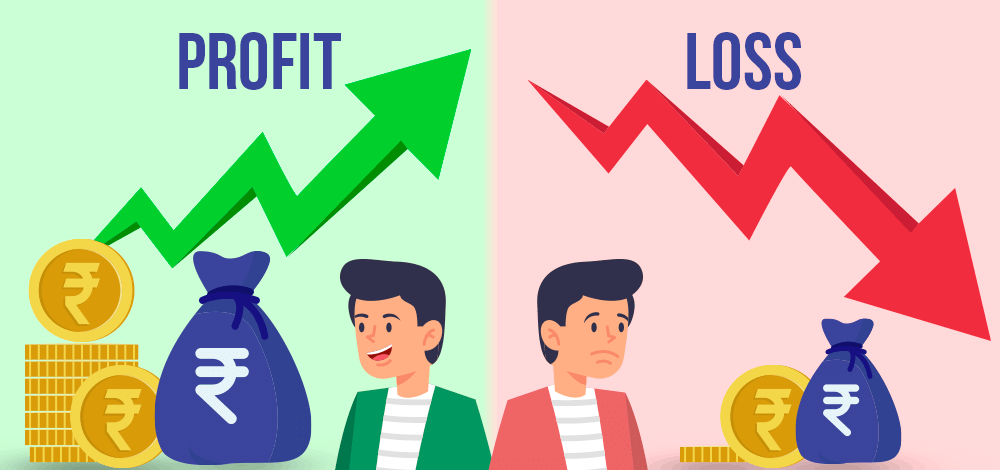Profit & Loss | Mental Maths - Class 1 PDF Download
| Table of contents |

|
| Introduction |

|
| Profit and Loss Related Terms |

|
| Profit and Loss Formulas |

|
| Profit and Loss Tricks |

|
Introduction
Profit and loss are common terms used to determine the profitability of a transaction. If the selling price exceeds the cost price, the difference is referred to as profit. Conversely, if the selling price is lower than the cost price, the difference is called a loss. The initial amount paid to buy a product is known as the cost price, while the amount at which the product is sold is called the selling price.

Profit and Loss Related Terms
When someone purchases an item at a specific price and then sells it at a different price, they either make a profit or experience a loss. There are several terms related to the process of conducting a transaction, such as the cost price of the item (C.P.), selling price (S.P.), discount, marked price, profit, and loss.
Let's explore the meanings of these terms individually:
Profit(P)
The amount gained by selling a product for more than its cost price.
Loss(L)
The amount the seller incurs after selling the product less than its cost price is mentioned as a loss.
Cost Price (CP)
The amount paid for a product or commodity to purchase is called a cost price. Also, denoted as CP. This cost price is further classified into two different categories:
- Fixed Cost: The fixed cost is constant, it doesn’t vary under any circumstances
- Variable Cost: It could vary depending on the number of units and other factors
Selling Price (SP)
The amount for which the product is sold is called the Selling Price. It is usually denoted as SP. Also, sometimes called a sale price.
Marked Price Formula (MP)
This is basically labelled by shopkeepers to offer a discount to the customers in such a way that,
- Discount = Marked Price – Selling Price
- And Discount Percentage = (Discount/Marked price) x 100
Profit and Loss Formulas
Now let us find the profit formula and loss formula:
- The profit or gain is equal to the selling price minus the cost price.
- Loss is equal to the cost price minus the selling price.
Profit or Gain = Selling price – Cost Price
Loss = Cost Price – Selling Price
The formula for the profit and loss percentage is:
- Profit percentage (P%) = (Profit /Cost Price) x 100
- Loss percentage (L%) = (Loss / Cost price) x 100
Profit and Loss Examples
- If a shopkeeper brings a cloth for Rs.100 and sells it for Rs.120, he has made a profit of Rs.20/-.
- If a salesperson has bought a textile material for Rs.300 and has to sell it for Rs.250/-, he has gone through a loss of Rs.50/-.
- Suppose Ram brings a football for Rs. 500/- and sells it to his friend for Rs. 600/-, then Ram has made a profit of Rs.100 with a gain percentage of 20%.
These are some common examples of the profit and loss concept in real life, which we observe regularly.
Profit and Loss Tricks

You have learned until now how to calculate profit, loss, and percentage of them. Now let us learn some tricks or formulas to solve maths problems based on gain and loss.
- Profit, P = SP – CP; SP>CP
- Loss, L = CP – SP; CP>SP
- P% = (P/CP) x 100
- L% = (L/CP) x 100
- SP = {(100 + P%)/100} x CP
- SP = {(100 – L%)/100} x CP
- CP = {100/(100 + P%)} x SP
- CP = {100/(100 – L%)} x SP
- Discount = MP – SP
- SP = MP -Discount
- For false weight, profit percentage will be P% = [(True weight – false weight)/ false weight] x 100.
- When there are two successful profits, say m% and n%, then the net percentage profit equals to [m + n + (mn/100)]
- When the profit is m%, and loss is n%, then the net % profit or loss will be: [m - n - (mn/100)]
- If a product is sold at m% profit and then again sold at n% profit then the actual cost price of the product will be: CP = [100 x 100 x P/(100+m)(100+n)]. In case of loss, CP = [100 x 100 x L/(100-m)(100-n)]
- If P% and L% are equal then, P = L and %loss = P2/100
|
29 videos|64 docs|19 tests
|
FAQs on Profit & Loss - Mental Maths - Class 1
| 1. What are some common profit and loss related terms? |  |
| 2. What are some important profit and loss formulas? |  |
| 3. Can you provide some profit and loss tricks for quick calculations? |  |
| 4. How can one analyze a company's profit and loss statement? |  |
| 5. How can one improve profitability in a business based on profit and loss analysis? |  |






















